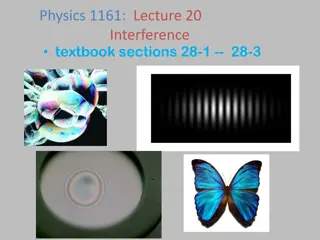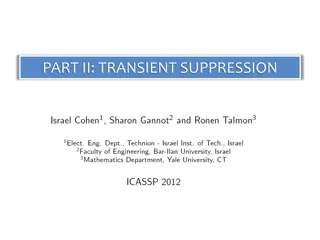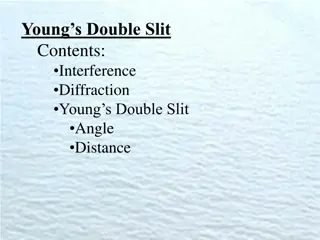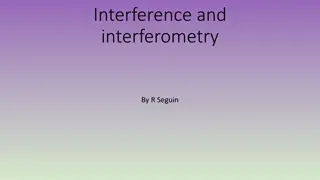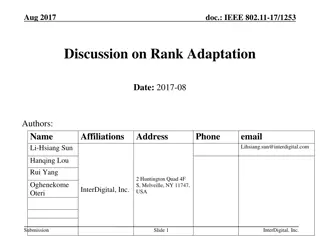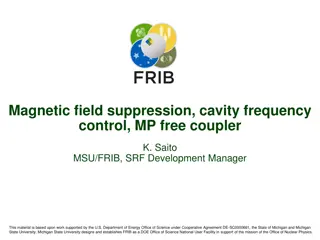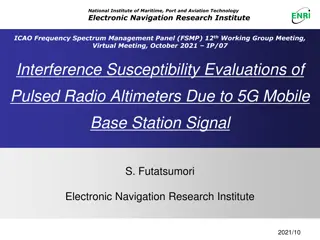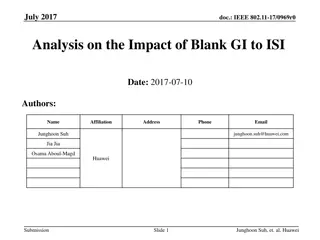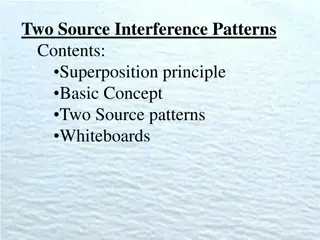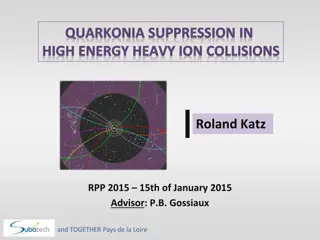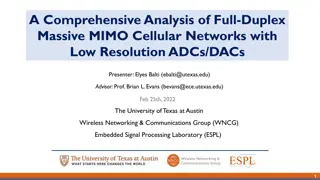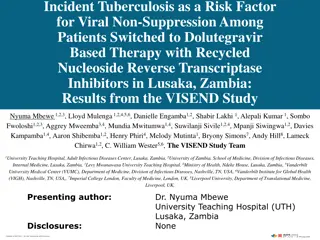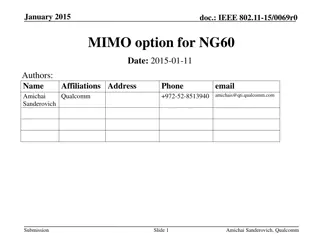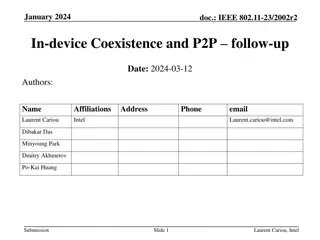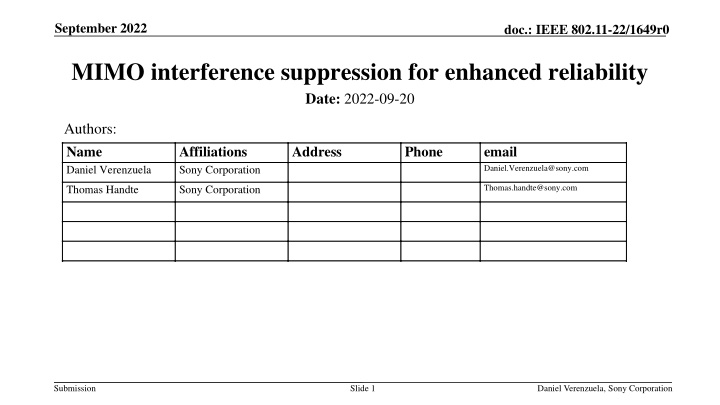
Enhancing Uplink Reliability with MIMO Interference Suppression in WLAN
Explore how MIMO interference suppression techniques can improve uplink reliability in WLAN environments, addressing the challenges of unpredictable interference from non-cooperative OBSS and other technologies. The presentation discusses the importance of covariance matrix estimation, spatial directions of desired channels versus interference, and practical applications of interference suppression using MIMO equalization.
Download Presentation

Please find below an Image/Link to download the presentation.
The content on the website is provided AS IS for your information and personal use only. It may not be sold, licensed, or shared on other websites without obtaining consent from the author. If you encounter any issues during the download, it is possible that the publisher has removed the file from their server.
You are allowed to download the files provided on this website for personal or commercial use, subject to the condition that they are used lawfully. All files are the property of their respective owners.
The content on the website is provided AS IS for your information and personal use only. It may not be sold, licensed, or shared on other websites without obtaining consent from the author.
E N D
Presentation Transcript
September 2022 doc.: IEEE 802.11-22/1649r0 MIMO interference suppression for enhanced reliability Date: 2022-09-20 Authors: Name Daniel Verenzuela Affiliations Sony Corporation Address Phone email Daniel.Verenzuela@sony.com Thomas.handte@sony.com Thomas Handte Sony Corporation Submission Slide 1 Daniel Verenzuela, Sony Corporation
September 2022 doc.: IEEE 802.11-22/1649r0 Introduction (1/2) A key objective for features proposed in UHR SG is to improve the STA s quality of service (QoS) which requires an increase the uplink (UL) reliability [1-4] Increasing the number of spatial streams (SS) has been considered as a side feature in UHR SG [1,2]. However APs with large number of antennas can increase the UL reliability, as it is shown in this presentation Submission Slide 2 Daniel Verenzuela, Sony Corporation
September 2022 doc.: IEEE 802.11-22/1649r0 Introduction (2/2) WLAN spectrum is subject to unpredictable interference Non-cooperative OBSS Other technologies (UWB, Bluetooth, NR-U) MIMO equalization can supress interference to increase reliability Need covariance matrix of interference channel Highly beneficial in the context of 16 SS Support of more SS can be used to increase reliability not just throughput 802.11be agreed to increase maximum number of LTFs beyond NSS [5,6] More LTFs are already available and can be used for extended training signals Extended training signals can enable Interference covariance matrix estimation Continuous observation of the channel Submission Slide 3 Daniel Verenzuela, Sony Corporation
September 2022 doc.: IEEE 802.11-22/1649r0 MIMO equalization to suppress interference Spatial directions spanned by desired channels are different from those spanned by interference Receiver can use estimates of interference covariance matrix to suppress interference Best ideal case (orthogonal spaces) practical case (different spaces) Worst case (parallel spaces) Spatial directions of channel estimates Spatial directions of interference channel e.g., Few RX antennas, no scattering, and highly correlated channels e.g., several RX antennas and some scattering e.g., Many RX antennas and rich scattering Submission Slide 4 Daniel Verenzuela, Sony Corporation
September 2022 doc.: IEEE 802.11-22/1649r0 MIMO equalization (1/2) Received signal at one given subcarrier of one OFDM symbol Assumptions for unpredictable interference Unsynchronized to received PPDU ???? is asynchronous to ??? and considered to be random and unknown Covariance matrix ???? of ???? does not change within PPDU Rough interference covariance matrix estimate NR-U dev. NR-U dev. Intended TX channel Unpredictable Interference STA Intended TX ??? ? = ??????+ ????+ ? ???? Accurate estimate from LTFs Intended TX signal Noise AP RX Submission Slide 5 Daniel Verenzuela, Sony Corporation
September 2022 doc.: IEEE 802.11-22/1649r0 MIMO equalization (2/2) MIMO equalization to suppress interference ? is MMSE receiver with additional term based on estimated interference covariance matrix ( ????) ???? can be estimated, e.g., from unused rows of P matrix Rough interference covariance matrix estimate NR-U dev. Intended TX channel estimates Estimated interference covariance matrix NR-U dev. STA 1 ??? Intended TX ? = ??? ??? ?+ ?? ????+ ?? ???? ??? ???? Regularization terms Accurate estimate from LTFs ? = ??? ??? AP RX Recovered signal after MIMO equalization ?: Hermitian transpose Submission Slide 6 Daniel Verenzuela, Sony Corporation
September 2022 doc.: IEEE 802.11-22/1649r0 Simulation results (1/2) Need more LTFs and RX antennas than spatial streams Intended transmitter STA TB-PPDU with MCS 4 Number of Spatial streams = 2 NLTF = 2 NLTF= 4 IntSup: Interference Suppression Interfering STA: legacy (unsynchronized) SNR = 3dB Receiver AP with Nr. RX antennas = 4 IntSup gain over MMSE having same NLTF: ~2dB IntSup gain over MMSE: ~3.5dB IntSup having NLTF = 2 NSS MMSE having NLTF = NSS Submission Slide 7 Daniel Verenzuela, Sony Corporation
September 2022 doc.: IEEE 802.11-22/1649r0 Simulation results (2/2) Need more LTFs and RX antennas than spatial streams Intended transmitter STA TB-PPDU with MCS 4 Number of Spatial streams = 2 NLTF = 2 NLTF= 6 IntSup: Interference Suppression Interfering STA: legacy (unsynchronized) SNR = 3dB Receiver AP with Nr. RX antennas = 6 IntSup gain over MMSE having same NLTF: ~3.5dB IntSup gain over MMSE: ~5.5dB IntSup having NLTF = 3 NSS MMSE having NLTF = NSS Submission Slide 8 Daniel Verenzuela, Sony Corporation
September 2022 doc.: IEEE 802.11-22/1649r0 What changes are needed in the specification Support of more SS More SS can be used to increase uplink reliability More SS requires more LTFs Unused rows of P matrix can be used to suppress uncontrollable interference May need to modify LTFs to avoid high overhead Support of extended training signals Requires LTFs to at least match number of Rx antennas for effective interference suppression Select NLTF independently from NSS for all PPDU types Define additional P matrices with larger sizes Define training fields that can track time-varying interference within a PPDU Submission Slide 9 Daniel Verenzuela, Sony Corporation
September 2022 doc.: IEEE 802.11-22/1649r0 Conclusion MIMO equalization with extended training signals can supress unpredictable interference at the receiver AP to increase UL reliability Extended training signals are supported by more LTFs Extended training signals can be further developed to enable continuous channel observation More benefits can be expected in context of 16 SS 16 SS can not only boost throughput but also increase reliability against interference such as OBSS Non-WLAN interference ,i.e., NR-U, UWB Submission Slide 10 Daniel Verenzuela, Sony Corporation
September 2022 doc.: IEEE 802.11-22/1649r0 SP Do you agree that interference suppression via MIMO is a promising technology for UHR? Yes, while keeping a maximum of 8 SS Yes, while adding more SS No Abstain Submission Slide 11 Daniel Verenzuela, Sony Corporation
September 2022 doc.: IEEE 802.11-22/1649r0 References [1] 11-22-1566-00-0uhr-views-on-uhr [2] 11-22-1580-01-0uhr- aperspectiveonproposeduhrfeaturesforenterpriseusecases [3] 11-22-1392-00-0uhr-beamforming-improvement-for-uhr [4] 11-22-1530-00-0uhr-multi-ap-coordination-for-next-generation-wi-fi [5] 11-20-1375-03-00be-eht-nltf-design [6] 11-21-1579-05-00be-cc36-cr-on-clause-9-4-2-295c Submission Slide 12 Daniel Verenzuela, Sony Corporation

